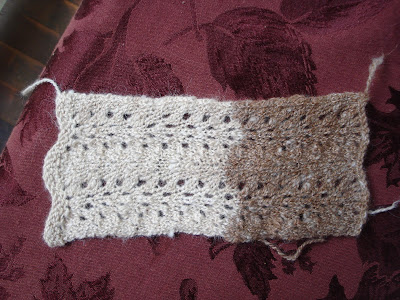I wrote about blending fibre for this project in an
earlier post. At the end, I noted that the results weren't what I was hoping for -- too many noils. I figured I could easily get rid of them so didn't fret too much over it. I have 112 g of this blended fibre -- wool, alpaca and silk -- I am not planning to abandon it without trying a few things.
Yesterday I heard back from Jenn with her measurements and confirmation that she wants me to make these gauntlets -- so I confronted the challenge of spinning this fibre into fingering weight yarn. It was a lovely lazy day. After struggling through a hot spell the threat of rain in the air was a welcome relief. I set myself up on the front porch, with my wheel, tools, and glass of cider.
As I mentioned earlier, this fibre ended up with a lot of noils in it. Some of them were from second cuts. That's when the shearer passes a second time over the piece being shorn and produces very short clumps of fibre. If I had paid closer attention, I could have removed these before I picked and blended the fibre. I was too excited about using the picker to blend the fibre that I didn't even look closely at the polworth. The other noils are not from second cuts, but seem to be from mishandling of the fibre. The polworth is a fine wool and it can't take the stress of the picker and then the drum carder. The fine fibres either break or get tangled and become a noil. Again, something entirely preventable.

You can see the noils in this photo. They are the white bits that are sitting in the fibre. I figured I could remove them so I got out my mini wool combs and tried combing them out. To no avail. The fibre is so fine the noils just slip past the tines and stay in the fibre. I tried drum carding it again, being much more gentle -- but no, they are still all there. Then I tried hand carding them, to pick out the second cuts and comb straight the other noils. Again, it didn't work.The noils are there to stay.
I started spinning. As I spun I stopped often to pick out the noils. It was slow going and not satisfying spinning. There had to be another way. The way I finally decided upon was to do a test swatch and as I spun ignored the noils. It was difficult because everything in me wanted the yarn to be smooth and not littered with these bumps. But really, what choice did I have? I could abandon this fibre or I could accept it as it is and see what it looked like spun up.
I spun a small (15g) sample as though the noils didn't exist. I washed it up and then to my surprise, fell in love with it.
It's not perfect yarn, but it is really lovely. The noils from the second cuts pop out on their own in the plying and washing. The other noils just get tucked into the yarn and create a bit a texture. The silk shines through, the wool gives it a bit of bounce and the alpaca some drape. I knit up a sample, see above, of the gauntlet.
I think this will do just fine.

















